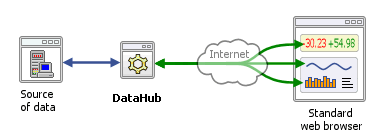| DataHub APIs for C++, Java, and .NET : Version 6.4 | ||
|---|---|---|
 | Chapter 2. Web Programming with Java |  |
Table of Contents
The DataHub lets you put live data into Java applets that are embedded in a web page. When the someone visits the web page, the Java applet attaches to the DataHub and the applet starts to receive live data updates without refreshing the page.

Here is an overview of how your code gets live data from the DataHub to a web page.
The Browser Loads the HTML

The Browser Loads the Java code

The Browser runs the Java code

Copyright © 1995-2010 by Cogent Real-Time Systems, Inc. All rights reserved.